This tutorial is a companion to the backhand loop vs backspin – side view tutorial, but showing a front view instead. Rather than repeat much of the side view version, I’ll just be pointing out items that are relevant to the front view.
Ready Position
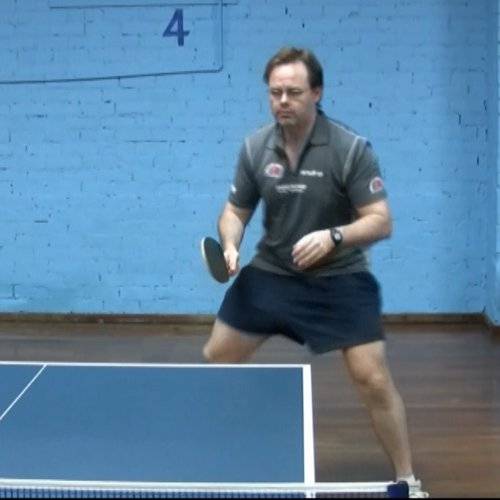
© Greg Letts
Points to look for:
- The player is currently facing the ball directly, with his shoulders fairly perpendicular to the ball, but with his right foot a little further back than his left foot (which allows a forehand to be played with little movement of the feet).
- The player is expecting the ball to come to his backhand side, which is why his bat is tilted slightly in favor of the backhand stroke, and his racket is held slightly further towards his backhand side than a truly neutral ready position would require.
Start Of Backswing
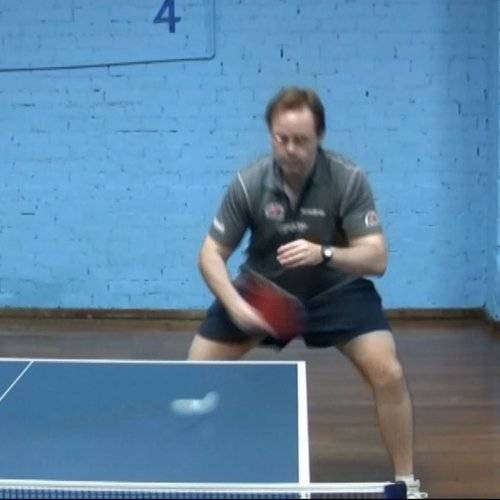
© Greg Letts
The opponent’s backspin ball has come to the backhand side and has bounced on the table. The player is beginning his backswing.
Points to look for:
- The player has bent his knees and leaned a little forward from his waist, in order to lower his body position to the best height to play the stroke, and also to give himself enough room to bring his bat back during the backswing.
- The player has turned his shoulders so that they now face squarely in the direction to which he intends to send the ball when it is hit.
- The racket has been brought backwards and downwards by rotating the right forearm around the elbow joint. Note that the elbow has not been moved sideways, since the ball will be contacted between the left hip and navel, not outside the player’s left hip.
- Note that the free arm has hardly moved at all, and will mainly be used for balance throughout the stroke.
- The player is watching the ball intently.
Middle Of Backswing
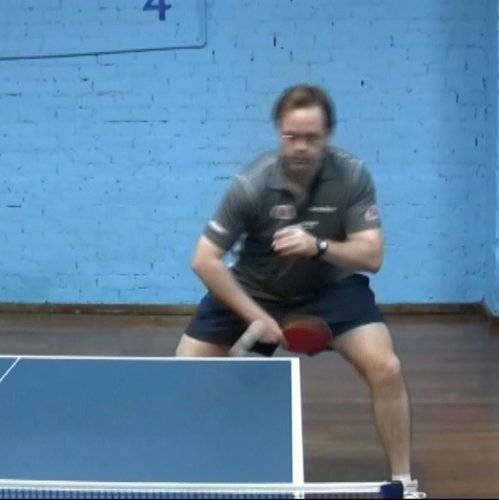
© Greg Letts
The ball is approaching the player, who is now in the middle of his backswing.
Points to look for:
- The player has brought his right shoulder forward a fraction, in order to give himself a little more room for his backswing.
- The right forearm has continued to move backwards and downwards, so that the right forearm is now roughly parallel to the player’s torso.
- The player has not yet started to cock his wrist, so the tip of the bat is pointing to his left. He will cock his wrist in the next fraction of a second, as shown in the following photograph.
- There is very little waist and shoulder turn throughout the whole stroke – most of the power is generated by the swinging of the forearm around the elbow, and by the wrist snap.
End Of Backswing

© Greg Letts
The player has been caught just at point where his backswing has finished, and he is beginning his forward swing.
Points to look for:
- The wrist has now cocked fully, so that the racket tip is now pointing backwards towards the player’s body. The racket angle is fairly closed, since that is the angle at which the player wishes to swing forward at.
- The forward swing begins with a little upward movement of the right elbow, while the right forearm begins to quickly swing forwards and upwards, retracing its path.
- The player has also pushed upwards a little with the legs, and straightened his upper body a fraction, which adds to the amount of lift generated.
- The player is still watching the ball closely.
Contact With The Ball
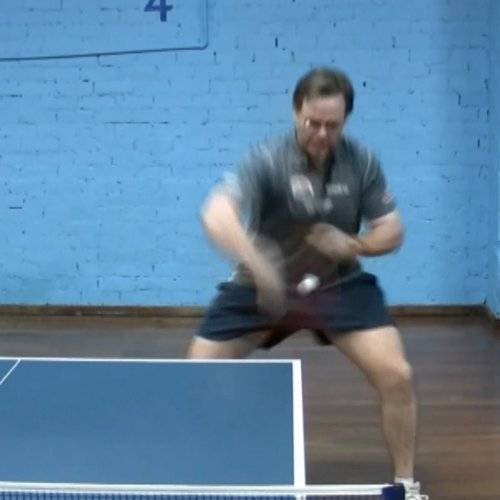
© Greg Letts
The player has made contact with the ball.
Points to look for:
- Compare the blur trail of the right hand to that of the ball. This clearly shows that although the right hand and bat are moving very quickly at impact, this racket speed has been used to generate a very heavy topspin, with only a medium amount of speed. This is because the player is looking to have plenty of margin for error if he misreads the amount of backspin put on the ball by his opponent.
- The snapping of the wrist has occurred just before impact, giving the racket maximal speed at impact.
- Note the relative stillness of the player’s legs and upper body. The only parts of the player’s body that are moving significantly are the right upper arm (a small amount), the right forearm (swinging fast around the elbow joint), and the right wrist (being snapped forwards and upwards).
- From this point of view, it is clear that contact with the ball has been made between the left hip and middle of the body. In this particular occasion it is slightly closer to the middle of the body. Making contact outside the left hip tends to unbalance the player during the swing, and is not recommended.
Start Of Follow Through

© Greg Letts
The ball has been struck, and the player is starting his follow through.
Points to look for:
- The playing arm has now been allowed to swing to the right once the maximum forward movement was reached, following the natural movement of the right arm.
- The free arm has been moved a little to the player’s left, in order to balance out the movement of the player’s right arm to his right.
- The player has pushed a little more upwards, but is still in a balanced position with knees bent and upper body leant a little forward.
- The comparison of the ball’s blur trail vs the racket’s blur trail emphasises that the racket speed has been turned into heavy spin and a lesser amount of ball speed.
- The right upper arm has lifted a fraction more, while the right forearm is still moving very quickly around the elbow joint.
End Of Follow Through

© Greg Letts
The forward swing has come to an end, and the ball is well on its way.
Points to look for:
- The right upper arm has reached the limit of its movement, stopping the right elbow a little short of shoulder height.
- The right forearm has continued to rotate around the elbow joint, and the racket has been stopped at around head height. Any further lifting of the elbow or racket head would increase the length of the stroke with little benefit, and make it more difficult to recover quickly for the next ball.
- The player is now lifting his head to start watching his opponent at the other end of the court, rather than the flight of the ball.
- The free arm has been moved a fraction more to the player’s left, to counterbalance the swinging of the playing arm to the right.
- The player has kept his knees bent, but has straightened his upper body a little more, so that he now has a very small lean forward.
Start Of Return To Ready Position

© Greg Letts
The player is now beginning his return to his basic ready position.
Points to look for:
- The bat is being returned to a vertical position, so that it will be ready for either a forehand or backhand stroke.
- The right arm is being dropped back into position, while the shoulders are turning to once again become square to the ball.
Return To Ready Position
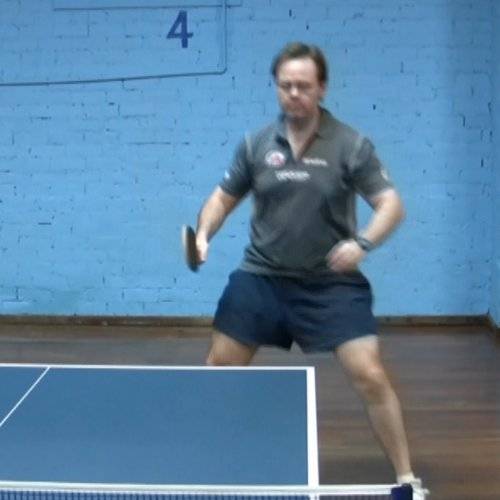
© Greg Letts
The player returns to his ready position before the next stroke.
Points to look for:
- The right arm has continued to drop into position, and the player is now in a fairly neutral ready position, while he watches his opponent play the ball.
- Rather than stand completely still, the player is about to perform a small adjusting “hop”, moving back a little. This is because he expects his opponent to block his attack, and the ball will probably land deeper and higher on his own side of the table, so the player needs to move back a little to have enough room to play the expected return comfortably. This is why the player appears a little more upright than normal – he is just about to jump backwards.
- Note that throughout the whole stroke, at no time was it necessary to move the right foot in front of the left foot. The stroke was played in a slightly forehand stance (with the right foot slightly behind the left foot). This is because there is very little waist and shoulder turn needed on the typical backhand loop. A more powerful backhand loop could be made by bringing the right foot forward and turning the waist and shoulders more, but the extra movement also increases the chances of making a mistake in timing the ball.

